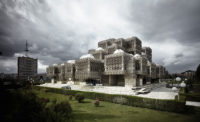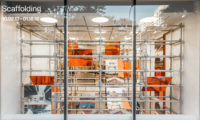If architecture is “frozen music,” it should follow that a building could stand still for its close-up. But as an exhibition called Image Building: How Photography Transforms Architecture makes clear, capturing the built environment on camera has long been a highly subjective enterprise. The show, at the Parrish Art Museum in Water Mill, New York (until June 17, and then traveling to the Frist Center for Visual Arts in Nashville, Tennessee), is a brisk survey of 57 images by 19 photographers, from the glittering night views of 1930s New York by Samuel H. Gottscho (1875–1971) and Berenice Abbott (1898–1991) to the gritty shots of a half-finished Caracas skyscraper, home to a community of squatters, by Iwan Baan (born 1975), a record contributing photographer.
With the rise of Modernism, a wide range of visual interpretations of buildings emerged, argues critic Marvin Heiferman in the show’s catalogue. While the great formal documentarians like Ezra Stoller (1915–2004) helped shape the heroic image of new architecture—see his 1958 view of the Seagram Building—a stripped-down design aesthetic also encouraged creative license. “The abstraction of the International Style seemed almost made for photographic expression,” wrote Akito Busch. Just one example: the interior of Eero Saarinen’s TWA terminal by Balthazar Korab (1926–2013), with its sexy curves of ramps and stairs flattened to a luscious pattern of swirls.
Many of the more recent photographs in the exhibition are highly personal visions. The poetically blurry images of famous buildings by Hiroshi Sugimoto (born 1948)—made with an old-fashioned 8-by-10 analog camera, using a long exposure—look like a fever dream. And the large-format, finely detailed color artworks of Thomas Struth (born 1954) are created with a heightened sense of reality. In his Pergamon Museum 1, Berlin, the museumgoers have been as carefully staged as an Old Master might have done in composing an epic painting, resulting in an image that is more about contemporary experience than the famous museum’s interior it depicts.









Post a comment to this article
Report Abusive Comment